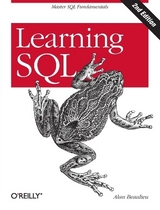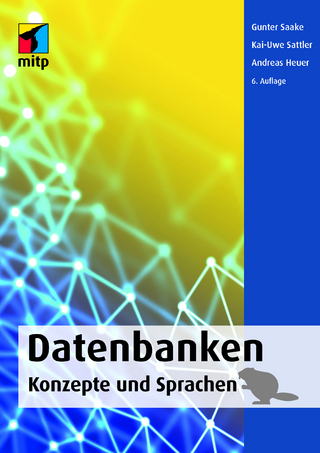
Learning SQL
O'Reilly Media (Verlag)
978-0-596-00727-0 (ISBN)
- Titel ist leider vergriffen;
keine Neuauflage - Artikel merken
SQL (Structured Query Language) is a standard programming language for generating, manipulating, and retrieving information from a relational database. If you're working with a relational database - whether you're writing applications, performing administrative tasks, or generating reports - you need to know how to interact with your data. Even if you are using a tool that generates SQL for you, such as a reporting tool, there may still be cases where you need to bypass the automatic generation feature and write your own SQL statements. To help you attain this fundamental SQL knowledge, look to "Learning SQL", an introductory guide to SQL, designed primarily for developers just cutting their teeth on the language. "Learning SQL" moves you quickly through the basics and then on to some of the more commonly used advanced features.
Among the topics discussed are: the history of the computerized database; SQL Data Statements - those used to create, manipulate, and retrieve data stored in your database; example statements include select, update, insert, and delete; SQL Schema Statements - those used to create database objects, such as tables, indexes, and constraints; how data sets can interact with queries; the importance of subqueries; data conversion and manipulation via SQL's built-in functions; and how conditional logic can be used in Data Statements. Best of all, "Learning SQL" talks to you in a real-world manner, discussing various platform differences that you're likely to encounter and offering a series of chapter exercises that walk you through the learning process. Whenever possible, the book sticks to the features included in the ANSI SQL standards. This means you'll be able to apply what you learn to any of several different databases; the book covers MySQL, Microsoft SQL Server, and Oracle Database, but the features and syntax should apply just as well (perhaps with some tweaking) to IBM DB2, Sybase Adaptive Server, and PostgreSQL. Put the power and flexibility of SQL to work.
With "Learning SQL" you can master this important skill and know that the SQL statements you write are indeed correct.
Alan Beaulieu has been designing, building, and implementing custom database applications for over 13 years. He currently runs his own consulting company that specializes in designing Oracle databases and supporting services in the fields of Financial Services and Telecommunications. In building large databases for both OLTP and OLAP environments, Alan utilizes such Oracle features as Parallel Query, Partitioning, and Parallel Server. Alan has a Bachelor of Science degree in Operations Research from the Cornell University School of Engineering. He lives in Massachusetts with his wife and two daughters and can be reached at albeau_mosql@yahoo.com.
Preface 1. A Little Background Introduction to Databases What Is SQL? What Is MySQL? What's in Store 2. Creating and Populating a Database Creating a MySQL Database Using the mysql Command-Line Tool MySQL Data Types Table Creation Populating and Modifying Tables When Good Statements Go Bad The Bank Schema 3. Query Primer Query Mechanics Query Clauses The select Clause The from Clause The where Clause The group by and having Clauses The order by Clause Exercises 4. Filtering Condition Evaluation Building a Condition Condition Types NULL: That Four-Letter Word Exercises 5. Querying Multiple Tables What Is a Join? Joining Three or More Tables Self-Joins Equi-Joins Versus Non-Equi-Joins Join Conditions Versus Filter Conditions Exercises 6. Working with Sets Set Theory Primer Set Theory in Practice Set Operators Set Operation Rules Exercises 7. Data Generation, Conversion, and Manipulation Working with String Data Working with Numeric Data Working with Temporal Data Conversion Functions Exercises 8. Grouping and Aggregates Grouping Concepts Aggregate Functions Generating Groups Group Filter Conditions Exercises 9. Subqueries What Is a Subquery? Subquery Types Noncorrelated Subqueries Correlated Subqueries When to Use Subqueries Subquery Wrap-up Exercisesm 10. Joins Revisited Outer Joins Cross Joins Natural Joins Exercises 11. Conditional Logic What Is Conditional Logic? The Case Expression Case Expression Examples Exercises 12. Transactions Multiuser Databases What Is a Transaction? 13. Indexes and Constraints Indexes Constraints A. ER Diagram for Example Database B. MySQL Extensions to the SQL Language C. Solutions to Exercises D. Further Resources Index
| Erscheint lt. Verlag | 27.9.2005 |
|---|---|
| Zusatzinfo | Illustrations |
| Verlagsort | Sebastopol |
| Sprache | englisch |
| Maße | 181 x 232 mm |
| Gewicht | 504 g |
| Einbandart | Paperback |
| Themenwelt | Informatik ► Datenbanken ► SQL Language |
| Informatik ► Office Programme ► Access | |
| Mathematik / Informatik ► Informatik ► Software Entwicklung | |
| ISBN-10 | 0-596-00727-2 / 0596007272 |
| ISBN-13 | 978-0-596-00727-0 / 9780596007270 |
| Zustand | Neuware |
| Informationen gemäß Produktsicherheitsverordnung (GPSR) | |
| Haben Sie eine Frage zum Produkt? |
aus dem Bereich

